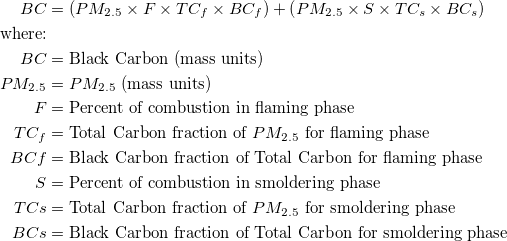Biomass Burning - peteWT/fcat_biomass GitHub Wiki
Estimating CO2 equivalent emissions from forest biomass burning

Key Findings
- Baseline emissions of Greenhouse Gas and Short Lived Climate Pollutant emissions from burning of forest management residuals can be estimated and should be considered in any forest management emsissions baseline.
- Total emissions from pile burning of foreat management resulals includine SLCP and GHG components extrapolated from CARB emissions inventory is XXX MTCO2e
Estimating black carbon emissions from biomass burning
Emissions from forest biomass burning are published in the most current statewide emissions inventory maintained by the California Air Resources Board. The Criteria Air Pollutant (CPE) emissions inventory and the Greenhouse Gas (GHG) emissions inventory are both necessary sources for establishing aggregate annual climate-forcing emissions. The GHG inventory captures gasses with radiative forcing properties but does not capture elemental carbon or black carbon (BC) emissions which have strong radiative forcing properties. While the Short Lived Climate Pollutant Strategy recognizes the importance of forest biomass management it does not publish an emission estimate fro BC.
The California Air Resources Board has published criteria air pollutant emissions estimates for 2015. Particulate matter as reported in the criteria air pollutant emissions inventory contains black carbon which is a strong short lived climate pollutant.
| gwp_20 | gwp_20_std | gwp_100 | gwp_100_std | gwp_500 | gwp_500_std | source | |
|---|---|---|---|---|---|---|---|
| 0 | 2200 | 888.82 | 633.33 | 255.41 | 193.33 | 77.67 | Fuglestvedt2000 |
| 1 | 3200 | nan | 900 | nan | nan | nan | CaliforniaAirResourcesBoard2015 |
| [Global warming potential estimates for black carbon from biomass burning] |
CARB reports emissions from PM 2.5 in tons/day. Black Carbon emissions can be estimated from PM 2.5 emissions if the ratio of smoldering to flaming combustion is known. Ward et. al. (1989) provide estimates of the ratio of smoldering to flaming combustion for a hand/machine piled burns, prescribed natural fire and wildfire. Black Carbon is a fraction of the Total Carbon (TC) component of PM 2.5. Thus BC is related to PM 2.5 by the equation:

Based on Ward and Hardy and Jenkins et. al., 1996, the following ratios are used here:
| Source | BC/t PM (F, est.) | TC/t PM (F, CV) | BC/t TC (F, CV) | BC/t PM (S, est.) | TC/t PM (S, CV) | BC/t TC (S, CV) |
|---|---|---|---|---|---|---|
| piles | 0.046904 | 0.09 | 0.45 | 0.01624 | 0.01 | 0.49 |
| prescribed natural fire | 0.0801631 | 0.0733 | 0.5833 | 0.020944 | 0.08 | 0.29 |
| wildfire | 0.0587012 | 0.0867 | 0.4467 | 0.0228641 | 0.06 | 0.338 |
To arrive at a rough estimate of BC emissions based on PM2.5 the following steps are taken
- Determine the amount of PM2.5 produced in the flaming and smoldering phases of combustion for each type (piles, wildland fire use, wildfire). Ratios from Ward and Hardy (1989, Table 5) are used.
- Define 1000 probability distributions for the percent of PM2.5 comprised of carbonaceous material (TC) and percent of TC comprised of black carbon (BC) give estimates and coefficient of variation estimates provided by Ward and Hardy (1989, tables 2 and 3)
- Estimate annual BC emissions based on probability distributions defines in 2.
The following plot represents estimates of total BC emissions resulting from combustion of biomass in the CARB CPE emissions categories reflecting woody biomass combustion in wildfire, pile burning and prescribed natural fire.

In addition the CARB's 1994 greenhouse gas emissions inventory estimates emissions from wildfire and slash burning through 2004.
| Source Category | MMTCO2 | |
|---|---|---|
| 0 | Forest and rangeland fires | 2.0194 |
| 1 | Timber harvest slash | 0.155267 |
TODO: Compare with co2 - pm ratio in Consume
To arrive at an estimate of total annual emissions from burning forest management residuals in CO2 equivalent terms from published CARB estimates we can combine the CO2 emissions reported for 2004 in the LULUC Biodegradable Carbon Emissions and Sinks with black carbon emissions extrapolated from the CARB Criteria Air Pollutant Emissions inventory estimates. The dime discrepancy between the 2004 and 2015 is acknowledged as an irreconcilable source of uncertainty in this estimation among others. This does however reflect that a baseline of substantial emissions from forest management residuals has been reported in CARB emissions inventories and should be recognized as a baseline condition. We find that a rough estimate of CO2e emissions from pile burning annual approaches 1 Mt CO2e.
| Mt CO2e | Source | |
|---|---|---|
| 0 | 0.17 | CO2 pile burning |
| 1 | 0.99 | CO2e BC pile burning |
| 2 | 1.16 | Total Mt CO2e |
BC emissions in terms of CO2e has not been included in any GHG emissions inventory published by CARB.
References
- Ward DE, Hardy CC. Organic and elemental profiles for smoke from prescribed fires. In: Watson JG, editor. International specialty conference of the Air and Waste Management Association [Internet]. San Francisco: Air and Waste Management Association; 1989. Available from: https://docs.google.com/uc?id=0B9-9Vlx0SkkFaU1ITkFjQnBXUEk&export=download
- Jenkins BM, Turn SQ, Williams RB, Goronea M, Abd-el-Fattah H, Mehlschau J, et al. Atmospheric Pollutant Emissions Factors From Open Burning of Agricultural and Forest Biomass By Wind Tunnel Simulations [Internet]. Sacramento, CA; 1996. Available here